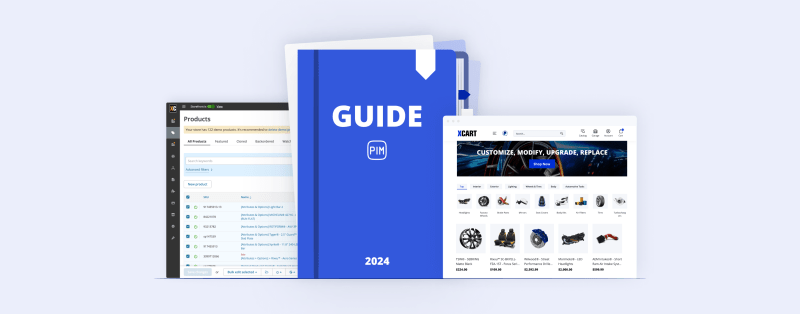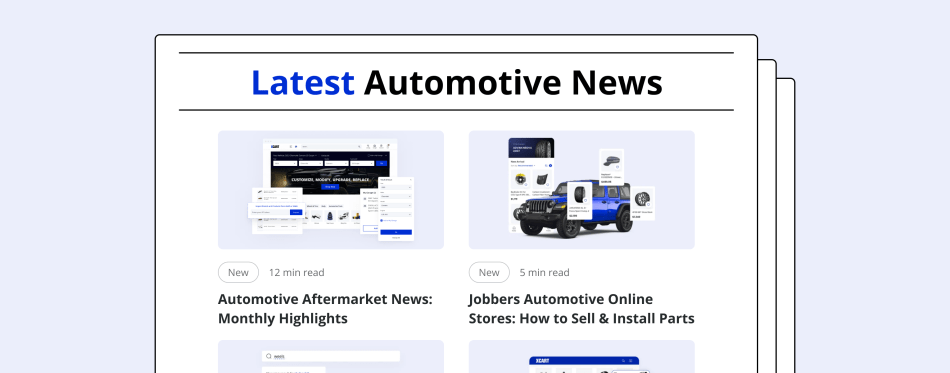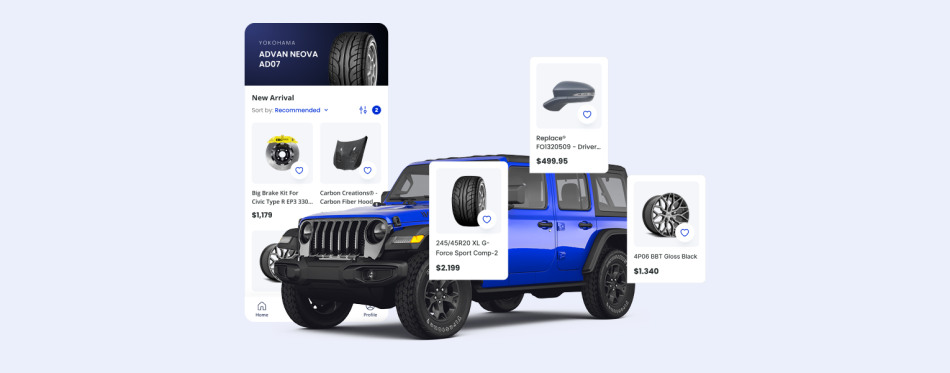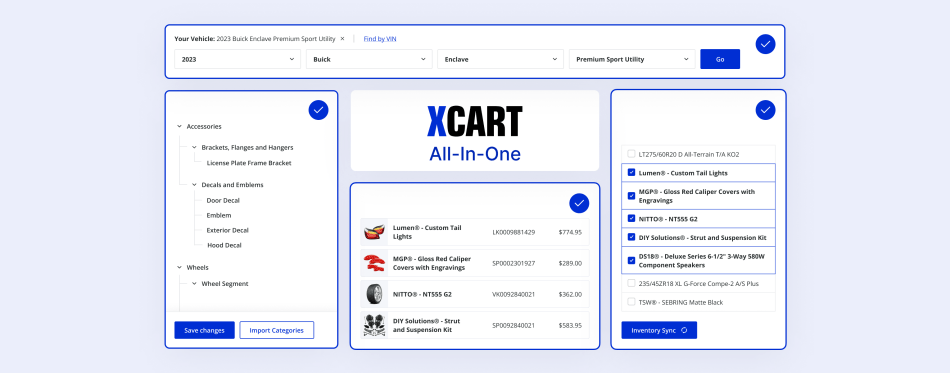Automotive Product Information Management
The complexities of automotive fitment data can feel like a Herculean task. Mid-sized businesses know it best. They strive to compete in a rapidly evolving market where it’s easy to become overwhelmed by:
- sheer volume of data;
- constant updates;
- pressing need for consistency across multiple platforms.
Many companies struggle with maintaining accurate and compliant product information. It often leads to frustrating customer experiences and lost sales opportunities.
But there’s a solution: a robust Product Information Management (PIM) system can streamline this process. According to industry insights, implementing a PIM can boost conversion rates by 20-50%. It can significantly enhance profitability and drive revenue growth through automation.
For mid-sized automotive businesses, this isn’t just a tech upgrade; it’s a strategic necessity. This guide will explore how to manage product information. We’ll help you define an effective PIM that’s compliant with industry standards like ACES and PIES.
What Is Automotive Product Information Management
Automotive PIM is a process that handles complex product data in the sector. It basically focuses on the automation of vast catalogs. Thus, it gets easier to update, categorize, and maintain accurate auto parts data across platforms.
Automotive PIM tackles a variety of data types that can be too noisy for the human eye:
| Data Type | Description |
| Technical Specifications | Details such as engine type, dimensions, and performance metrics. |
| Images | Product photos and diagrams that showcase the item. |
| Pricing | Retail prices, discounts, and price history. |
| Stock Levels | Current inventory status and availability. |
PIM systems bring much value to auto parts companies, including better resource allocation and less manual work. Automotive PIM centralizes and manages this data to ensure you stay current for the customer. This centralization helps maintain an efficient and user-friendly eCommerce experience and streamline internal operations.
Another valuable function of product information management for automotive industry is compliant data management. It’s easy to get lost in the dynamic legislation that regulates commerce and industry. In particular, effective automotive product data management hinges on compliance with ACES (Aftermarket Catalog Exchange Standard) and PIES (Product Information Exchange Standard). These standards provide essential standardization for fitment accuracy and product information.
Summing up: Using eCommerce product information management systems streamlines communication across the supply chain, minimizes manual errors, and fosters better collaboration. All because accurate and consistent data improves customer experiences and confidence. A robust automotive PIM solution helps manage these complexities of data integration and ongoing compliance, too.
What’s the Right PIM System for Automotive
The right PIM system will address specific automotive needs. Here’s what to consider in the first place:
- Scalability: Choose a PIM system that can expand your business. For example, it should handle growing product catalogs and customer bases without slowing down.
- Automotive UX: Opt for systems with automotive-specific features, like fitment search based on YMM and VIN, or even visualizer tools to improve user experience and satisfaction.
- Cost-efficiency: Assess the total cost, including setup and maintenance. A cost-efficient system should reduce manual work and long-term operational costs, such as through automated data updates.
- Security: Select a product information management system with strong security features like encryption and access controls to protect sensitive data and ensure regulatory compliance.
- Integrations with catalog providers: Ensure the system integrates well with catalog providers such as SEMA Data, ASAP Network, and AutoSync. This will secure seamless data synchronization and efficient operations.
- Integrations with warehouse distributors: The system should also integrate with such distributors as Keystone Automotive Operations, Turn 14 Distribution, and American Tire Distributors (ATD) to let the stock and pricing update automatically.
- In-house support: Opt for a PIM with reliable in-house support to quickly resolve issues and provide guidance.
- Customization options: Look for a system that allows customization to fit your specific automotive needs, including data fields and workflows.
- Knowledge base: Choose a comprehensive PIM, including tutorials and FAQs, to facilitate self-service troubleshooting and learning.
So, take these factors into account and select a solution that best suits your needs and supports long-term growth.
Benefits of Product Information Management
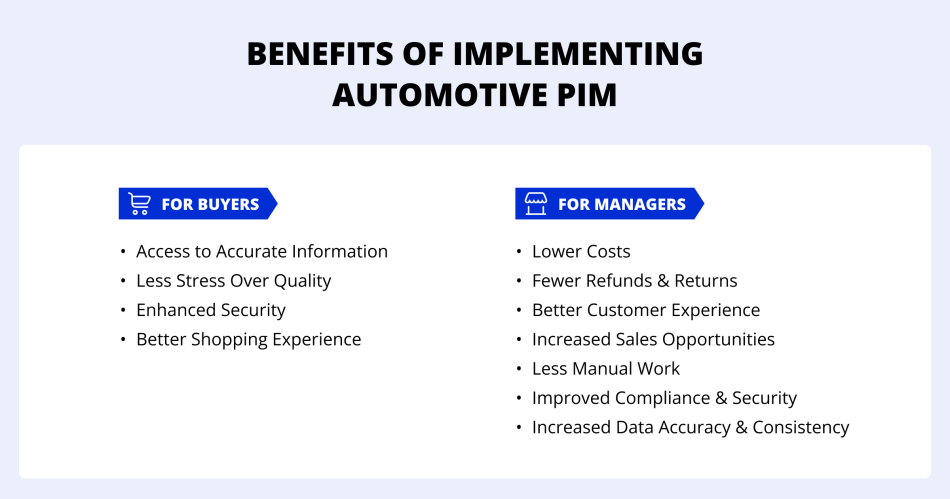
A product information management system is helpful to both automotive eCommerce managers and buyers. That is why the benefits of successful adoption can range from gaining trust and boosting customer loyalty to providing a transparent purchasing experience that leads to larger sales volumes.
Benefits of product information management for automotive eCommerce managers:
- Lower costs. By automating data management processes, eCommerce managers can reduce operational costs. This enables better allocation of resources to other areas, such as marketing or inventory management.
- Fewer refunds and returns. Improved accuracy in product data and fitment information leads to a decrease in return rates. This also reduces the costs associated with returns.
- Repeat business. Higher customer satisfaction with the already purchased parts leads to a growing loyal customer base.
- Increased sales opportunities. Accurate product visibility and fitment options contribute to an increase in sales. When customers can easily locate the parts they need, they are more likely to complete their purchases.
- Reduced manual work. Implementing a PIM system allows auto parts retailers to automate data handling. This reduces the time spent on manual updates. For instance, managers won’t need to manually enter fitment data, correct pricing discrepancies, or update product descriptions for new arrivals.
- Improved compliance. Automated updates ensure that product data meets industry standards, such as ACES and PIES, making it easier for buyers to find compliant parts that meet their vehicle’s specifications.
- Enhanced security. Advanced security measures, including role-based access controls and encryption, protect sensitive buyer information and transaction data.
- Increased data accuracy & consistency. Synchronizing product specifications across the retailer’s website and mobile app ensures that buyers receive consistent information, reducing confusion over fitment and specifications for parts.
Сustomers become more demanding. They value ease of use and clear navigation during checkout. Hence, automotive retailers now need to focus on the end customer first. Meeting these expectations is essential for driving sales growth.
Benefits of product information management for buyers include:
- Access to accurate information. With a product information management system, buyers receive up-to-date and accurate product information. For instance, they can find the exact fitment details for parts like alternators or brake pads and ensure compatibility with their vehicles.
- Less stress over quality. Buyers can easily find parts that comply with industry standards, such as ACES and PIES. This means they can trust that the products they purchase will meet necessary safety and performance requirements.
- Enhanced security. Robust security measures protect buyers’ personal and payment information during transactions. This ensures a safe shopping experience, giving buyers confidence when purchasing auto parts online.
- Better shopping experience. The ability to filter search results based on specific vehicle details, like make and model, allows buyers to quickly find the right parts. This reduces frustration and enhances the overall shopping experience.
As you can see, adopting an automotive product information management system is a worthwhile investment when executed correctly. To maximize these benefits, take time to research and anticipate potential challenges.
Challenges of Automotive Product Information Management
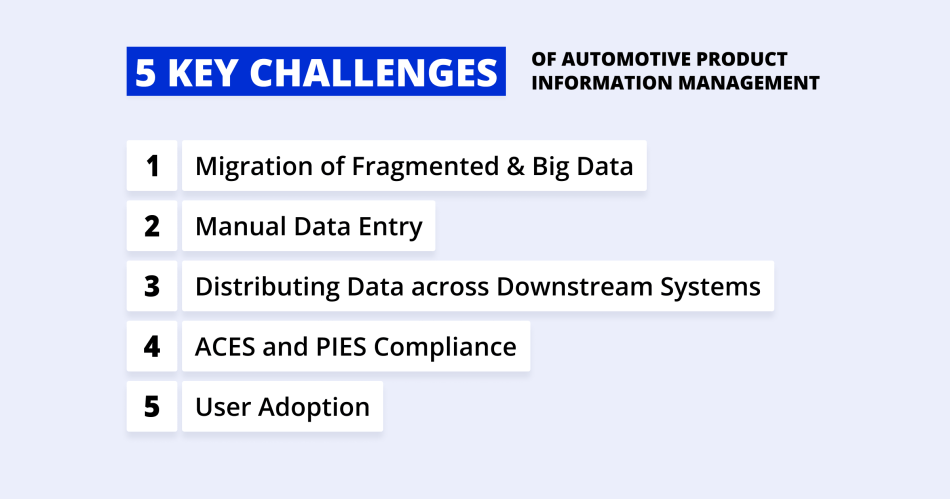
Implementing automotive eCommerce product information management can present several challenges:
1. Migration of Fragmented & Big Data
Migrating product data to a new product information management system in the automotive sector is often complex and time-consuming. Large retailers might struggle to upload fitment specifications, pricing, and descriptions from various legacy systems.
Fragmented data sources can lead to potential data loss and inconsistencies. For example, if an auto parts retailer has information spread across different spreadsheets for brake pads, rotors, and filters, this can create discrepancies. As well as, launching a new line of parts without consolidating this data risks providing customers with inaccurate information.
2. Manual Data Entry
Many automotive retailers still depend on manual data entry despite technological advancements. Small auto parts shops that regularly add new products might spend hours inputting pricing and specifications. This time-consuming process is prone to errors, such as typos in part numbers, which can lead to customers ordering the wrong items.
Such mistakes result in returns and frustrated buyers, ultimately harming the store’s reputation.
3. Distributing Data across Downstream Systems
For automotive eCommerce businesses, sharing accurate product data across different systems can be challenging. Automotive distributors may need to sync inventory data between their eCommerce platform and physical stores. If there are discrepancies in data formatting or updates, a customer might order a part online only to discover it’s out of stock at the store. These inconsistencies can undermine customer trust and result in lost sales.
4. ACES and PIES Compliance
Compliance with ACES and PIES standards is vital in the automotive sector. Retailers often struggle to format their product data correctly. Customers may have trouble finding the right parts if a retailer fails to map their data according to ACES standards. This causes frustration and potential penalties from regulators.
5. User Adoption
Getting team members to adopt a new product information management system can be difficult in the automotive industry, where precision is key. Employees accustomed to old processes may resist change or struggle with the new interface. Auto parts staff might need extra training to use advanced fitment features and manage bulk updates. Without proper support, this transition can hinder productivity.
Solution: Invest in a reliable eCommerce product information management solution combined with expert support. A robust automotive PIM, backed by professional implementation and training services, can ensure smooth data source management, automated product data updates, consistent data across channels, and effective user adoption.
Key Components of Automotive PIM
Automotive PIM solutions rely on several essential functionalities that together shape the effective operation of your eCommerce store:
| Key Feature | What It Does | How It Helps |
| Automated Catalog Management | 👉 streamlines management of extensive auto parts catalogs, 👉 allows quick updates of fitment data. | 👉 reduces time spent on manual updates, 👉 minimizes errors in SKU details that can lead to wrong part orders. |
| Integration with Data Providers | 👉 ensures access to accurate, standardized fitment information from auto parts databases like SEMA Data, AutoSync, and ASAP Network. | 👉 eliminates discrepancies from manual entry, 👉 ensures compatibility across multiple catalogs, 👉 enhances trust among customers. |
| Bulk Updates and Imports | 👉 facilitates rapid updates for thousands of SKUs, 👉 is essential for managing seasonal changes in inventory. | 👉 minimizes downtime during bulk changes, 👉 prevents potential lost sales during high-demand periods like holidays. |
| Data Synchronization Across Channels | 👉 keeps product information consistent in real-time across eCommerce platforms and physical retail locations. | 👉 reduces the risk of overselling or stock discrepancies, 👉 is crucial for maintaining customer satisfaction in the automotive market. |
| Mapping of Product Categories | 👉 simplifies mapping parts to categories using ACES and PIES standards, 👉 enhances searchability for customers. | 👉 mitigates confusion caused by differing naming conventions from various distributors, 👉 improves customer navigation on websites. |
| Automated Order Management | 👉 streamlines order processing and shipping, 👉 is crucial for timely delivery of auto parts to retailers and consumers. | 👉 reduces manual errors in order fulfillment, 👉 minimizes delays that can lead to customer dissatisfaction and lost sales. |
| Partnerships with Warehouse Distributors | 👉 automates updates on product availability, 👉 ensures timely restocking and dropshipping from distributors like Turn 14 Distribution, ATD, and Keystone Automotive Operations. | 👉 eliminates complexities of manual fulfillment, 👉 enables faster order processing and accurate inventory management. |
It’s even better when these features come built into your eCommerce platform. The processes become smoother without the need to search for separate PIM software. Everything you need is already included, and that’s exactly what X-Cart offers.
X-Cart Automotive can assist you on your first journey to optimize your auto parts eCommerce business. X-Cart Automotive is designed to automate and elevate every facet of your online store. It gives automotive PIM features required to secure a long-term flawless operation.
How X-Cart Helps with Automotive PIM
X-Cart simplifies automotive PIM by integrating reliable data from catalog providers like SEMA Data, ASAP Network, and AutoSync. This means you can effortlessly upload accurate product details—dimensions, weights, and fitments—without the hassle of spreadsheets, all while complying with ACES and PIES standards and keeping prices & stock updated in real-time.
Centralization is the key focus of X-Cart. It allows you to manage product information across all sales channels for seamless category mapping with your chosen data providers. This streamlined approach reduces errors and enhances efficiency.
For order management, X-Cart connects you to major distributors like Turn 14 Distribution, ATD, and Keystone Automotive Operations. It enables quick inventory uploads and effective routing to the nearest warehouses. This fosters fast delivery of car parts.
Additionally, X-Cart makes it easy to sell on platforms like Amazon and eBay Motors. You can sync categories and product details directly from the admin panel, automate inventory updates, and manage order processing seamlessly.
Finally, X-Cart’s CloudSearch engine includes built-in Year/Make/Model filters. They help customers easily find the right parts for their vehicles, backed by up-to-date fitment data. X-Cart’s PIM capabilities allow for growth, accommodating expanding product catalogs and evolving customer needs without compromising performance.
Ready for Effective eCommerce Product Information Management?
Shift to Automotive Product Information Management
Adopting an effective automotive PIM solution is critical for mid-sized businesses looking to thrive in competitive eCommerce.
Key Takeaways
- Implementing robust PIM can increase conversion rates by 20-50%, enhancing profitability and driving revenue growth for mid-sized businesses.
- Automotive PIM centralizes product data, making it easier to update, categorize, and maintain accurate information across multiple platforms.
- Effective PIM solutions ensure compliance with industry standards like ACES and PIES. This reduces the risk of inaccuracies and penalties.
- Accurate and consistent product information improves customer trust and leads to better shopping experiences and fewer returns.
- Automating data updates and integrating with catalog providers reduces manual work. This helps streamline internal operations and cut costs.
- The right product information management system grows with your business. It handles expanding product catalogs and customer bases seamlessly.
- Choose a PIM that offers strong security features and reliable in-house support to protect sensitive data and resolve issues quickly.
- Look for PIM solutions that allow customization to fit specific automotive needs. It will ensure a tailored approach to data management.
- A comprehensive knowledge base within the product information management system helps facilitate user self-service troubleshooting and learning.
- Investing in a PIM is not just a tech upgrade; it’s a strategic necessity for automotive businesses aiming for success in a competitive market.
- Taking advantage of a flexible platform like X-Cart empowers you to centralize and manage product data seamlessly. You will stay compliant with industry standards and enhance customer experience.
With its ongoing improvements and expanding integrations, X-Cart provides the tools necessary for efficient inventory management, streamlined order fulfillment, and effortless connectivity to major auto parts data suppliers. Investing in a robust eCommerce solution today will set the stage for your success tomorrow.
Adopt Product Information Management for the Automotive Sector
About the author

